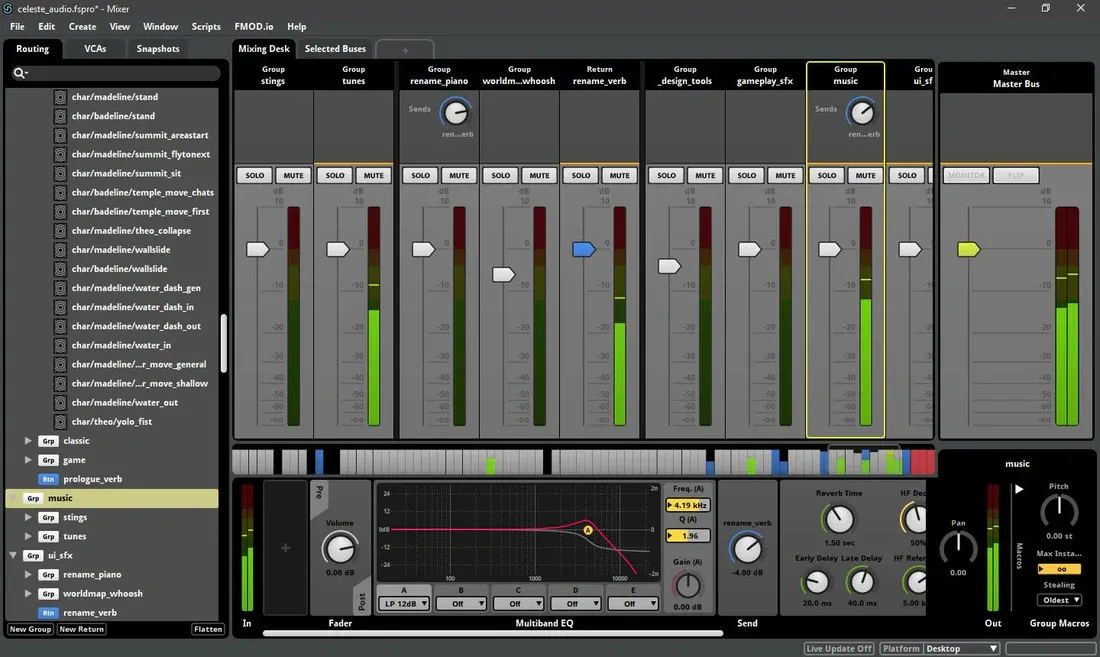Game Audio: Industry Middleware - By Adam Ridland

What is Audio Middleware?
Audio middleware is software that the audio team uses to handle audio
processing in their games. It provides them with the tools to create and manage
complex soundscapes, sound effects, and music, as well as control how they are
played back in the game. Audio middleware acts as a bridge between the game
engine and the audio engine, which allows for the team to integrate sound
effects, music, and voiceovers seamlessly. The two most popular audio
middleware solutions for game development are Wwise and FMOD.

What is Wwise?
Wwise is an audio middleware solution developed by Audiokinetic Inc. It is
used in various game development engines, including Unity, Unreal Engine,
and CryEngine, and is a popular choice for game audio implementation. Wwise
provides developers with an integrated environment for creating, testing, and
implementing interactive sound effects and music in their games. Its features
include real-time mixing, 3D audio spatialization, advanced sound processing,
and interactive music composition.
Wwise also has a comprehensive set of tools for sound designers and
composers, such as the ability to create soundbanks, add sound effects, and
manage music playlists. It supports a wide range of audio formats and
platforms, including PC, console, mobile, and VR.
Wwise is sometimes seen as a more advanced choice when it comes to
middleware given its complex look and advanced features some feel it’s very
much like a spreadsheet but it is incredibly powerful and used by most studios
from indie to AAA.
What is FMOD?
FMOD is another popular audio middleware solution used in game
development. It was developed by Firelight Technologies and is used in game
engines such as Unity, Unreal Engine, and CryEngine. FMOD is equipped with
a set of tools for creating, editing, and implementing sound effects, music, and
voiceovers in their games.

FMOD features include real-time mixing, 3D audio spatialization, advanced
sound processing, and an event system for triggering sounds based on game
events. It also has a range of tools for sound designers and composers, such as
the ability to create and manage sound banks, add sound effects, and create
dynamic music. All this is done in a very different way than to Wwise. FMOD
supports various audio formats and platforms, including PC, console, mobile,
and VR.

FMOD is great for those starting out as it looks like a traditional DAW with that
familiarity being a huge part of its success. However, FMOD from what I’ve
seen is used primarily by indie studios or participants during Game Jams.
Wwise is in fact more powerful and has more features but this can be scary for
new comers and it has a steeper learning curve to that of FMOD.
Final Words:
End of the day. an Audio Lead or Director (depending on the company) will
advise if middleware is used or not. If not, the engine’s native system can also
be used to implement sounds into the engine. The person making this call will
decide based on the project size, specifications and budget to what middleware
is more appropriate to use. My recommendation is to learn both Wwise and
FMOD and that might seem overkill however both are very good for different
things and for different projects. My personal preference is Wwise but I will use
FMOD if I need to. Flexibility is good. Oh and if you’ve started learning one
and finding it tricky do not panic there are tons of resources. Practice makes
perfect.
Sound Design Fun Fact:
Did you know that the sound effect of Darth Vader's breathing in the Star Wars
movies was created by recording the sound of a scuba regulator? Sound
designer Ben Burtt came up with the idea when he heard his own breathing
inside his scuba diving helmet. He then recorded the sound of a scuba regulator
and added some post-processing effects to create the iconic sound of Vader's breathing.





